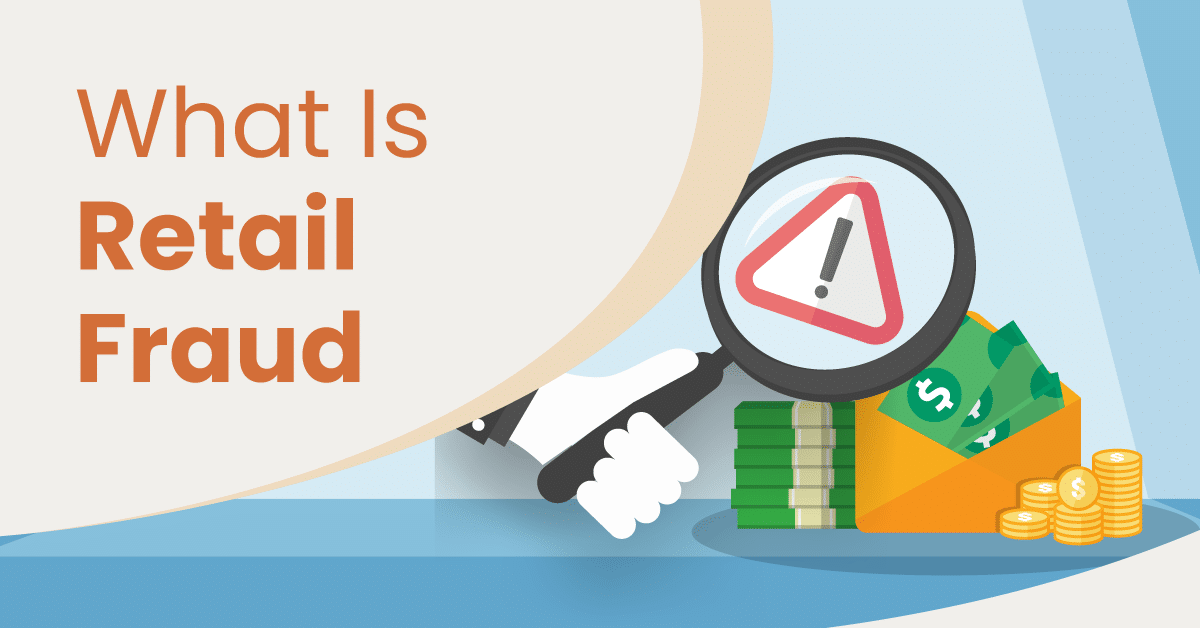
Retail fraud, also known as retail theft or shoplifting, refers to stealing merchandise, money, or services from a retail establishment. This pervasive issue has been a longstanding concern for businesses worldwide.
Retail fraud takes various forms, making it a multifaceted challenge for retailers to combat effectively. This article delves into the different methods of retail fraud, its impact on businesses, and the strategies retailers use to prevent and detect fraud.
Types of Retail Fraud
Perpetrators of retail fraud employ various methods to avoid detection and maximize their gains. They often target busy periods or understaffed stores, taking advantage of chaotic situations.
1. Shoplifting
Shoplifting is the most common form of retail fraud, where individuals steal items from stores without paying for them. In the US, stores lose $45 million daily due to shoplifting!
Shoplifters often use techniques such as concealing merchandise, using foil-lined bags to evade security alarms, or working in groups to distract employees.
2. Return Fraud
The NRF puts return fraud at a whopping $23 billion per year. Return fraudsters manipulate receipts or exploit lenient return policies. They often return stolen merchandise or items purchased with stolen money to the store in exchange for cash, store credit, or gift cards.
Return fraud can also involve returning used or damaged items as new.
3. Employee Theft
Employees can engage in fraud by stealing merchandise, misusing discounts, or processing false refunds. This type of theft is particularly challenging to detect as it involves individuals within the organization. Employees engaged in fraud may collude with external criminals, create fictitious transactions, or manipulate inventory records to cover their tracks.
In addition to the direct financial losses and shrinkage incurred, internal fraud erodes the trust between employees and management, damaging the workplace environment.
4. eCommerce Fraud
With the rise of online shopping, eCommerce fraud has become highly prevalent. eCommerce fraudsters exploit vulnerabilities in online payment systems, using stolen credit card information or engaging in account takeovers to make unauthorized purchases.
Phishing scams, where fraudsters trick customers into revealing sensitive information, are also shared online. They often include schemes such as card-not-present fraud, account takeovers, and phishing scams. In these instances, criminals exploit online payment systems and sensitive customer information.
5. Organized Retail Crime (ORC)
ORC involves organized groups stealing large quantities of merchandise for resale in illegal markets. These groups often target multiple stores, making it difficult for individual retailers to combat them effectively.
Many big box retailers cite ORC as a direct cause of store closure nationwide.
Impact on Businesses
Retail fraud has significant consequences for businesses, both financially and operationally. The direct financial losses from stolen merchandise and fraudulent activities substantially affect a retailer’s profitability and sustainability. Additionally, the costs associated with implementing security measures and investigating incidents further strain a company’s resources.
Retail fraud impacts businesses indirectly by eroding customer trust. High levels of theft can increase product prices, negatively affecting law-abiding customers. The need for stringent security measures also creates an unwelcoming atmosphere in stores, potentially deterring genuine customers.

Prevention and Detection Strategies
Retailers employ preventive measures and advanced technologies to combat retail fraud effectively. Below are a few of the most important strategies:
1. Investing in Technology
Data analytics and machine learning algorithms are employed to detect patterns indicative of fraudulent activities. Retailers use security cameras, electronic article surveillance (EAS) systems, and RFID tags to monitor and protect merchandise.
RFID technology implementation helps prevent retail theft by enabling efficient merchandise tracking from supply chain to store. Integrated with anti-theft systems, RFID tags trigger alarms if unauthorized items exit the store.
This technology also allows quick and accurate inventory counts, reducing opportunities for theft. RFID integration with EAS systems enhances security, providing a multi-layered approach to prevent retail theft.
2. Employee Training
Training staff members to recognize suspicious behaviors and encouraging them to provide excellent customer service empowers retail employees to act as the first defense against theft. When vigilant and proactive, employees can deter potential thieves merely through their presence and attentive service.
Well-trained cashiers and salespeople prevent theft and fosters a safe and secure shopping environment, enhancing the overall customer experience. Regular training and reinforcement of these practices ensure that employees remain alert, ultimately reducing instances of theft and promoting a positive atmosphere within the retail space.
3. Strict Return Policies
Stringent return policies are a powerful deterrent against fraudulent activities. By mandating proof of purchase and setting limitations on returns without receipts, retailers create a barrier for individuals attempting to manipulate the system for personal gain.
These policies protect businesses from financial losses and maintain the integrity of the return process. This ensures that retailers meet genuine customer needs while deterring those with malicious intentions.
4. Cybersecurity Measures
In addition to encryption and multi-factor authentication, eCommerce platforms often invest in cutting-edge technologies such as machine learning algorithms and artificial intelligence to detect and thwart potential fraud in real-time.
These advanced systems analyze patterns of user behavior, transaction history, and other data points to identify any unusual activities or suspicious transactions. Regular security audits to assess vulnerabilities ensure the platform remains resilient against evolving cyber threats. By employing this comprehensive approach, eCommerce platforms safeguard customer data and uphold online shoppers’ trust.
Fostering a secure environment allows consumers to engage in digital transactions confidently.
5. Modern Surveillance Cameras
Modern surveillance cameras offer high-definition video capabilities, enabling retailers to capture clear, detailed footage of their store premises. These cameras often come with advanced features such as motion detection and facial recognition, allowing for swift identification of suspicious activities and potential shoplifters.
Additionally, some surveillance systems are integrated with artificial intelligence, enabling automatic analysis of customer behavior to detect anomalies and prevent theft proactively. These sophisticated cameras act as a strong deterrent, discouraging potential criminals and significantly improving asset protection.
“With a modern point of sale system, we witnessed a significant reduction in retail fraud. The integration of advanced technology streamlined our operations and provided robust security measures. Real-time analytics and tracking helped us pinpoint suspicious activities promptly, enabling us to take proactive measures. The result? A safer shopping environment for our customers and a substantial decrease in fraudulent incidents, ultimately bolstering our bottom line.”
Rob F.- Today’s Toys
5. Smart Point of Sale
Point of sale (POS) systems are a powerful tool to both deter theft before it happens and identify instances of theft after the fact. Firstly, these systems often have powerful inventory management, automatically updating stock levels with each sale. This real-time tracking quickly identifies discrepancies and minimizes opportunities for employees or shoplifters to steal items unnoticed.
Smart POS systems implement user-specific access controls, ensuring only authorized personnel can access sensitive functions, reducing internal theft risks. These systems can generate detailed transaction reports, enabling managers to analyze sales data and identify irregularities or suspicious patterns, leading to early detection of potential theft.
KORONA POS has exceeded my expectations in every way. It’s a powerful, adaptable solution that has transformed our operations for the better.
-James B.
Conclusion
Retail fraud poses a significant challenge to businesses, impacting their financial stability, customer trust, and overall operations. With the continuous evolution of tactics employed by fraudsters, retailers must stay vigilant and adopt innovative strategies to prevent, detect, and deter retail fraud effectively.
Investing in modern retail tools like KORONA POS offers employee and inventory management, as well as retail loss prevention features to mitigate the impact of retail fraud and create a secure environment for businesses and customers. Click the link below to learn more about how KORONA POS can help you combat retail fraud.
FAQs: Retail Fraud
Fraud in retail refers to any deceptive or dishonest activity aimed at obtaining goods, services, or money illegally. This can include practices such as shoplifting, employee theft, refund fraud, credit card fraud, and inventory shrinkage. Retail fraud encompasses various tactics individuals or employees employ to gain financial advantage or goods without proper payment, leading to financial losses and compromised business integrity for retailers.
Fraud at a store involves any deceptive or dishonest activity committed within a retail establishment with the intent to gain goods, services, or money illegally. Often, this involves actions like shoplifting, employee theft, altering price tags, refund fraud, or using counterfeit currency. Store fraud undermines the store’s revenue, impacts profitability, and often leads to increased prices for honest customers to compensate for losses.
Two common examples of retail fraud are shoplifting and return fraud. Shoplifting occurs when customers steal merchandise from a store without paying for it, leading to financial losses for the retailer. Return fraud involves customers returning items they did not purchase, often using counterfeit receipts or claiming false reasons for the return. Both types of fraud impact a retailer’s profitability and may lead to increased prices to offset these losses.














